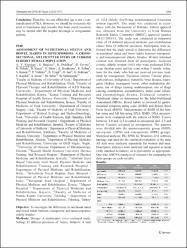| dc.description.abstract | Objective: To investigate the differences in nutritional status
and bowel habits between osteoporotic and nonosteoporotic
elderly females
Methods: Design: A multicenter cross-sectional study.
Setting: 12 different provinces of Turkey. Subjects: A total
of 1224 elderly free-living postmenopausal Caucasian
women (age>65). This study was conducted in accordance with the Declaration of Helsinki. Ethical approval
was obtained from the University of Usak Human
Research Ethics Committee (HREC) approval number
HREC/2018/11. The study was conducted in outpatient
clinic of 15 different physical medicine and rehabilitation
clinics from 12 different provinces. Participants were informed that the study aimed to determine the differences
in nutritional status and bowel habits between osteoporotic and nonosteoporotic elderly females. Written informed
consent was obtained from all participants. Inclusion
criteria: elderly women (>65) who were performed DXA
scans (lumbar spine and hip scan) within 1 month, volunteers for the study who had not received previous treatment for osteoporosis. Exclusion criteria: Chronic glucocorticoid use, malignancy, metabolic bone disease, neurogenic bladder, neurogenic bowel, other malnutrition diseases, use of drugs causing malabsorption, use of drugs
causing constipation, nonambulatory status renal failure,
and rheumatologic disease. Evaluated variables;
Nutritional status as determined by the Mini-Nutritional
Assessment (MNA). Bowel habits as assessed by gastrointestinal symptom rating scale (GSRS) and Bristol Stool
Form Scale (BSFS). Measurements of BMD of the lumbar spine and left hip using DXA. BMD: DXA measurements were evaluated with the criteria of WHO. T-score
between -1.0 and -2.5 accepted as osteopenia and -2.5 and
below T-scores accepted as osteoporosis. The patients
were divided into the nonosteoporotic group (NOP),
osteopenic (OPN) and osteoporotic (OPR) groups.
Statistical analysis: The SPSS for Windows 12.0 software
package was used for the statistical evaluation of the data.
All data were analyzed separately for women and men.
Descriptive statistics were analyzed and reported as mean
(with standard deviation), or as percentiles as appropriate.
One-way ANOVA (analysis of variance) for comparing for
three groups on each variable. | en_US |


















